Abstract
A novel alkali-induced grafting polymerization was designed to synthesize a PFGPA proton exchange membrane based on the co-grafting of α-methyl styrene (AMS) and acrylonitrile (AN) into the poly(vinylidenedifluoride) (PVDF) membrane. Three kinds of alkali treatments were used: by immersing the PVDF membranes into a 1 M NaOH solution and mixing the PVDF powders with 16% or 20% Na4SiO4. Then, AMS with AN could be co-grafted into the PVDF backbones in two grafting solvents, THF or IPA/water. Finally, the grafted membranes were sulfonated to provide the PFGPA membranes. In the experiments, the Na4SiO4 treatments showed a greater grafting degree than the NaOH treatment. The grafting degree increased with the increasing amount of Na4SiO4. The grafting solvent also influenced the grafting degree. A 40–50 percent grafting degree was obtained in either the THF or IPA/water solvent after the Na4SiO4 treatment and the THF resulted in a greater grafting degree. FTIR and XPS testified that the PFGPA membranes had been prepared and a partial hydrolysis of the cyano group from AN occurred. The PFGPA membranes with the grafting degree of about 40–50 percent showed a better dimensional stability in methanol, greater water uptake capabilities, and lower ion exchange capacities and conductivities than the Nafion 117 membranes. The PFGPA membrane with the 16% Na4SiO4 treatment and THF as the grafting solvent exhibited a better chemical stability. The obtained experimental results will provide a guide for the synthesis of alkali-grafted PFGPA membranes in practical use.
1. Introduction
Recently, proton exchange membrane fuel cells (PEMFCs) have attracted more and more attention as portable, clean, and efficient electrochemical energy conversion systems due to their low operation temperature, long lifetime, and high power density [1]. The proton exchange membrane (PEM) is one of the key components of the PEMFCs, which provide the channel for the proton transportation [2]. Nafion, a perfluorosulfonic acid polymer with high ion conductivity, thermal, and mechanical stability, is the most successfully commercialized PEM [3]. However, Nafion membranes exhibit the drawbacks of high cost, low performance under the low relative humidity condition, which limits the commercial application on a large-scale [4]. Hence, many efforts have been made to develop alternative membranes as substitutes for Nafion [5] such as the organic/inorganic hybrid membranes [6,7], sulfonated aromatic polymers [8], blended Nafion composite membranes [9], and fluorine containing polymers by grafting polymerization [10]. Sulfonated aromatic polymers exhibit excellent water uptake capability, ion exchange capacity, and conductivity. Their shortcomings are the great swelling and bad dimensional stabilities, which further deteriorate the mechanical properties of the membranes in application. Fluorine containing polymers [10] including the fluorinated (PTFE, FEP, and PFA) or partially fluorinated (PVDF and ETFE) membranes possess excellent chemical and thermal stability, but never have conductive groups. Therefore, how to introduce ion exchange groups into the fluorinated polymeric matrix is the key to successfully preparing the fluorinated PEMs.
Radiation grafting is an effective way to prepare the PEMs for fuel cells [11,12,13]. The properties of the membranes can be easily controlled by modifying the grafting polymerization parameters. Styrene (St) [14], due to its low cost and adjustable ion exchange capacity by sulfonation, is an appropriate material to be radiation-grafted into the fluorinated membranes. In addition, acrylonitrile (AN), methylacrylonitrile (MAN) [15], and dimethylaminoethyl methacrylate (DMAEMA) [16] are also applied. It is noted that radiation grafting is strict to the polymerizing instrumentation due to the use of high energy γ- and X-ray, which is relatively toxic and expensive.
Recently, Qiu [17] proposed an alkali (NaOH) solution-induced grafting polymerization to synthesize the PVDF-g-PSSA membrane, which displayed a higher conductivity of 0.1119 S/cm at 25 °C and lower methanol permeability than Nafion. Guo [18] investigated the tetrasodium orthosilicate (Na4SiO4)-induced grafting polymerization of PVDF with a polystyrene sulfonated acid membrane. The experimental results indicated that polystyrene was easily grafted into the PVDF by an alkali solution. With the increasing content of NaOH or Na4SiO4, the proton conductivity of the PVDF-g-PSSA membranes were gradually increased.
Styrene, or its sulfonated derivatives, is the most commonly utilized radiation grafting monomer into fluorinated polymers. However, the main shortcoming of polystyrene derivatives is that the benzylic C–H bond is easily broken to form benzyl radicals, resulting in a subsequent chain scission by β-fragmentation [19,20]. Using fluorinated monomers (e.g., α, α, β-trifluorostyrene (TFS)) can increase the chemical stability. Nevertheless, TFS possesses low grafting kinetics [21] and sulfonation degree [22], leading to a too long reaction time and unacceptable ion exchange capacity. Using the pre-sulfonated monomers (e.g., sulfonyl fluoride containing TFS derivatives [21]) can improve the grafting kinetics, but they are too expensive to be utilized on a large-scale. Ring-substituted styrenic monomers such as p-methylstyrene or p-tert-butylstyrene have also been studied as alternative monomers in order to increase the chemical stability [23]. Theoretically, α-methyl styrene (AMS), a α-substituted styrenic derivative that is commercially available, is the most chemically stable, and the polymerized AMS showed superior stability to polystyrene under oxidized conditions [24]. However, the homopolymerization of AMS is difficult due to the low steric hindrance of the α-methyl group and low ceiling temperature [25]. Grafting of AMS with other monomers such as AN or methacrylonitrile (MAN) [26,27,28] could enhance the polymerization conversion. However, few studies have been found on the alkali grafted PVDF with AMS and its co-monomers.
In this paper, alkali-induced grafting proton exchange membranes with co-grafting PVDF with α-methylstyrene and acrylonitrile were reported. The effects of the types and contents of the alkalis and solvents on the grafting polymerization were investigated and the obtained PVDF-based proton exchange membranes (PFGPA) were characterized in terms of the morphology, liquid uptake capability, swelling, ion exchange capacity (IEC), conductivity, mechanical property and so on. The PFGPA membranes possess excellent dimensional stability and low swelling in methanol, indicating a potential application prospect. Due to the advantages of low cost, ease of preparation, and relative environmental-friendliness, the alkali grafting polymerization is attractive and exhibits a new approach to synthesizing PFGPA membranes.
2. Materials and Methods
2.1. Materials
Kynar® polyvinylidene fluoride (PVDF) resins for batteries (Mw = 400,000~600,000) were purchased from Arkema, France. Alpha-methylstyrene (AMS) was purchased from Futian Chemical Com., Zhaoqing, China. Acrylonitrile (AN), N-methyl pyrrolidone (NMP), dibenzoyl peroxide (BPO), tetrasodium orthosilicate (Na4SiO4), 1,2-dichloroethane, tetrahydrofuran (THF), isopropanol (IPA), hydrogen peroxide, and methanol were purchased from Guangfu Fine Chemical Com., Tianjin, China. All reagents were used as received except that AN and AMS were distilled prior to use.
2.2. Preparation of the PFGPA Membranes
Preparation of the PFGPA membranes is shown in Scheme 1. Two types of alkalis, NaOH and Na4SiO4, were used to treat the PVDF membranes.
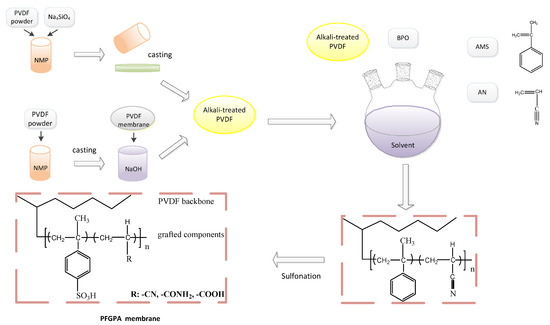
Scheme 1.
The preparation of the PFGPA membranes.
NaOH treatment process: Certain amounts of PVDF powders and NMP solution were mixed, stirred for 2 h, and poured onto the glass plate. The obtained PVDF membranes were dried under vacuum at 60 °C for 10 h. Then, they were immersed into a 50 mL 1.0 M NaOH ethanol solution with 150 mg tetrabutylammonium bromide (TBAB) being added at 60 °C for 20 min. The treated PVDF membranes were washed by deionized water to neutral.
Na4SiO4 treatment process: Certain amounts of PVDF powders were dissolved in NMP solution containing 3 wt.% deionized water, then the Na4SiO4 powders were added. The mixture was stirred for 2 h, poured onto the glass plate and dried under vacuum to afford the Na4SiO4-treated PVDF membranes, expressed as “PVDF_Na4SiO4 percent”.
Before grafting, the alkali-treated PVDF membranes were swelled in 1,2-dichloromethane for 2 h. These were respectively immersed into a solvent, IPA/water (I/W) or THF, for grafting polymerization with AN and AMS as the co-monomers and BPO as the initiator. The grafting polymerization was performed at 50 °C for 60 h. The obtained PVDF-g-P(AMS-AN) were washed with acetone and 1,2-dichloromethane three times, 2 h each, to remove the residue reactants on the surface and dried under vacuum at 60 °C for 12 h. The grafting degree (GD) of the PVDF-g-P(AMS-AN) was calculated according to Equation (1).
where is the grafting degree; m0 and m1 are the masses of the PVDF membranes before and after the grafting polymerization, respectively.
Afterward, the grafted PVDF membranes were swelled in 1,2-dichloromethane for 2 h. Then, they were sulfonated in a mixture of chlorosulfonic acid/1,2-dichloromethane (5:100, v:v) at room temperature for 2 h [26] to obtain the PFGPA membranes. The PFGPA membranes were washed with deionized water to neutral and dried under vacuum. The obtained PFGPA membranes were expressed as “PFGPA_X_Y”, where X represents the NaOH or percent of Na4SiO4 and Y represents the grafting solvent, respectively.
2.3. SEM
Morphologies of the samples were observed on a S-4800 field emission scanning electron microscope from Hitachi, Japan. Prior to the measurement, the samples were dried in the vacuum oven at 60 °C for 24 h and sprayed with Au powders on the surfaces.
2.4. IR Analysis
FTIR was performed on a Nicolet iS50 spectrometer from ThermoFisher Scientific Co., Ltd, Shanghai, China. The spectra were measured in transmittance mode in a wavenumber range of 4000–600 cm−1 with a resolution of 8 cm−1.
2.5. XPS
The X-ray photoelectron spectroscopy (XPS) was performed with a D8 DISCOVER instrument from BRUKER, Germany, with monochromatic Al Kα radiation (1600 W, 40 KV, 40 mA) and 2θ range of 5–45°. The XPS data were analyzed and curve fitted by the XPS peak software.
2.6. Liquid Uptake Capability and Swelling Ability
The membranes were cut into the dimensions of about 2 × 2 cm2 and dried at 120 °C for 2 h to completely remove the absorbed water to afford the dry weight, length, and width. The liquid uptake capabilities were measured in three types of liquids: deionized water, 1 mol/L methanol aqueous water, and pure methanol, respectively. The membranes were immersed into the liquid at room temperature, taken out periodically, and the water on the surface was quickly removed using filter paper to provide the wet weight, length, and width.
The liquid uptake capability and area swelling were calculated according to Equations (2) and (3), respectively,
where and are the mass and surface area in the dry, respectively; and are the mass and surface area in the wet, respectively.
2.7. Chemical Stability
The PFGPA membranes were tailored into the dimensions of 2 × 2 cm2. Chemical stability tests were evaluated by the degradation experiment of immersing the membranes into 30 wt.% H2O2 aqueous solution at 60 °C for 6 h. Then, the membranes were intermittently taken out from the H2O2 solution and weighed after wiping off the water on the surface.
2.8. Ionic Exchange Capacity
Ionic exchange capacities (IECs) of the PFGPA membranes were determined by acid–base titration. Before the test, the dried PFGPA membrane was immersed into a 0.05 mol/L NaOH solution for 24 h. Afterward, the membrane was taken out and washed with deionized water several times. The washed water was combined and poured into the NaOH solution. Then, the NaOH solution was neutralized with a 0.06 mol/L HCl solution. IEC (mmol·g−1) was calculated according to Equation (4).
where and are the volume of NaOH and HCl (mL), respectively; and are the concentration of NaOH and HCl (mol·L−1), respectively; is the weight of the membrane in the dry.
2.9. Proton Conductivity
The proton conductivity measurement was performed by a double probe method in SI 1287 AC impedance, UK. The membranes were placed between two Pt electrodes with the fixed distance under the AC voltage of 10 mV. Conductivities of the membranes were examined at room temperature according to Equation (5).
where is the resistance (Ω) of the sample; and are the thickness and the width, respectively; of 1.5 cm represents the distance between two Pt electrodes.
2.10. Mechanical Measurement
The mechanical properties of the modified PVDF membranes were measured by a strong electronic universal material testing machine at room temperature. The membranes were fixed with clamps with the distance of 25 mm. The clamps were moved at the speed of 20.0 mm/min until the membrane was broken.
3. Results and Discussion
3.1. Preparation of the PFGPA Membranes
PVDF possesses excellent chemical and thermal stability and it is hard to directly introduce the other structural units into the polymeric backbone. In order to facilitate the grafting polymerization, two types of alkalis, NaOH and Na4SiO4, were used to generate the active reaction points in PVDF. Alkali treatments affect the positions and amounts of the active points in PVDF. The NaOH treatment was performed by immersing the PVDF membranes into a 1 M NaOH solution at 60 °C for 20 min and the alkali-corrosion generally happened on the surfaces of the PVDF membranes. The Na4SiO4 treatment was performed by mixing the PVDF powders with Na4SiO4 in NMP, so that the active points were distributed evenly on the cross-section [29] of the PVDF membranes, maximizing the likelihood of the grafting polymerization.
Afterward, the active PVDF membranes were immersed into a mixture containing the co-monomers and the initiators to perform the grafting polymerization. The effects of the alkali, the solvents, and amounts of the monomers on the grafting degree were discussed. In the grafting polymerization, two types of grafting solvent, THF and IPA/water, were used, which influenced the solubility of the monomers and compositions, structures, and properties of the resulted polymers. In the IPA/water solvent, AMS and AN are hydrophobic and immiscible. Gubler [28] proposed that due to the poor polarity of AMS, using the IPA/water solvent (5:2, v/v) could increase the effective AMS concentration at the grafting front, resulting in a higher AMS incorporation into the graft copolymer. When an AMS molar fraction of 0.6 in the feed composition was required, the AMS:AN molar ratio of 1:1 in the graft component was obtained. In our experiments, an AMS molar fraction of 0.6 by Gubler’s method was used.
Table 1 lists the parameters of the alkali, monomers, and solvents in the grafting polymerization. When the amounts of AMS and AN were lower, the grafting degree by the NaOH treatment was about 2 percent in either the IPA/water or THF solvent (No. 1, 4). The grafting degree by the Na4SiO4 treatment increased with the increasing amount of Na4SiO4 in either the IPA/water (No. 2, 3) or THF (No. 5, 6). For the 20% Na4SiO4 treatment, the IPA/water solvent exhibited a greater grafting degree of 20 percent than 13.8 percent in THF. When the volume ratio of AMS/AN to the solvent increased to 4:1, the IPA/water solvent resulted in a greater grafting degree of about 30–50 percent (No. 7–9). For the NaOH treatment, the grafting degree exceeded 30 percent. The treatment of 16% Na4SiO4 reached a grafting degree of 49 percent, greater than 43.61 percent of the 20% Na4SiO4, manifesting a potential application prospect. When THF was used as the solvent, in order to improve the grafting degree, AlCl3, a Lewis acid, which had successfully improved the radiation-induced grafting polymerization of PVDF [30,31], was used to effectively catalyze the alkali-induced grafting polymerization in our experiments. The obtained grafting degree was slightly greater than that in IPA/water (No. 10–12). These experimental results indicate that the PVDF-g-P(AMS-co-AN) with a grafting degree of 40–50 percent had been successfully achieved in either the IPA/water or THF solvent system.

Table 1.
The preparation of the PFGPA membranes.
Finally, the PVDF-g-P(AMS-co-AN) membranes were sulfonated according to the literature [26] to obtain the resulted PFGPA membranes.
3.2. Characterization of the PFGPA Membranes
3.2.1. Morphologies
The PFGPA membranes were obtained sequentially by alkali treatment, grafting polymerization, and sulfonation. Figure 1 reveals the SEM photographs of the PVDF membranes after alkali treatment. It was found that the pristine PVDF membrane possessed a smooth surface. After the PVDF membrane was treated by 1 M NaOH solution, they still remained smooth, but several tiny holes and cracks appeared. The PVDF membranes by the 16% Na4SiO4 treatment manifested a slightly uneven thickness and some shallow strips emerged. Treatment with 20% Na4SiO4 further magnified the nonuniformity of the thicknesses and several defects caused by mixing the Na4SiO4 were clearly observed. It was concluded that whenever NaOH or Na4SiO4 were utilized, the alkali treatments led to a structural damage of the PVDF membranes. This is because the alkali treatment destroyed the PVDF backbones, generating the active points to perform the grafting polymerization.
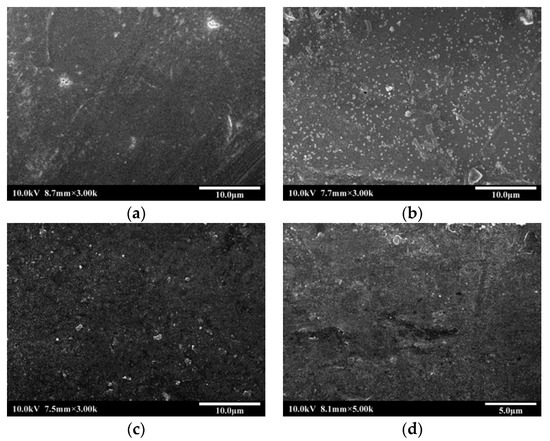
Figure 1.
The morphologies of the PVDF membranes by various alkali treatments. (a) pristine PVDF; (b) treatment by NaOH; (c) treatment by 16% Na4SiO4; (d) treatment by 20% Na4SiO4.
After alkali treatment, the PVDF membranes were graft polymerized, respectively, in two solvents, IPA/water or THF. Figure 2 shows the morphologies of the grafted PVDF membranes. In the IPA/water solvent, the grafted PVDF membranes with NaOH treatment showed a rough, uneven surface with a few holes. In comparison, the THF solvent resulted in more and greater holes, indicating a worse mechanical property. For the treatment by 16% Na4SiO4, the grafted PVDF membranes in the IPA/water manifested many thin and scaly stripes, along which a few tiny cracks were found. Treatment by 20% Na4SiO4 led to folded scaly stripes, rougher surfaces, and greater cracks. Distinctly, when THF was used as the solvent, the grafted PVDF membrane with the treatment of 16% Na4SiO4 showed a relatively smooth surface and a few holes were evidently formed. For the treatment by 20% Na4SiO4, the membranes possessed more and greater holes, but still remained smooth.
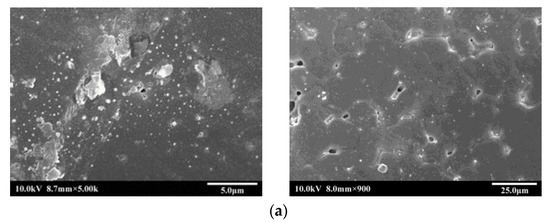
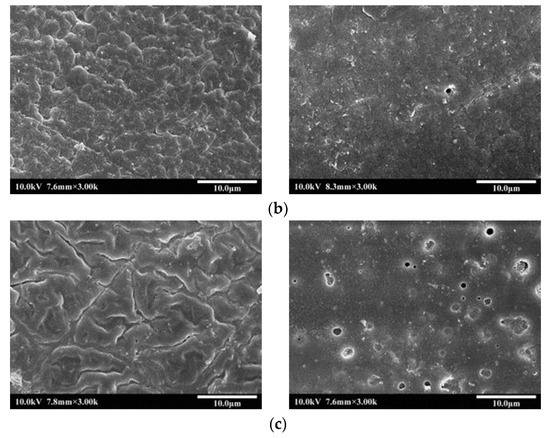
Figure 2.
The morphologies of the grafted PVDF membranes with various alkali treatments in IPA/water (left) and THF (right). (a) 1 M NaOH, (b) 16% Na4SiO4, (c) 20% Na4SiO4.
Our experimental results showed that the solvents distinctly influenced the morphologies of the grafted PVDF membranes. These could be explained by the differences in the solubilities of AN and AMS in IPA/water and THF. When the grafting polymerization was performed in IPA/water, AN and AM tended to concentrate on the side of the IPA and were grafted into the PVDF backbones. On the side of water, due to the insolubility, less AMS and AN were grafted. Concentration differences in AN and AMS caused by the heterogeneity of the IPA/water solvent brought about a nonuniform surface of the grafted PVDF membranes. When THF was used, the AN and AMS were dissolved well and the grafting polymerization could be performed evenly, which led to a smooth surface.
Finally, the grafted PVDF membranes were sulfonated by chlorosulfonic acid to afford the PFGPA membranes (Figure 3). The PFGPA surfaces in the grafting solvent of IPA/water with three alkali treatments of 1 M NaOH, 16% and 20% Na4SiO4, respectively, all showed scaly surfaces, along with longer and deeper cracks, and somewhere the scales fell. For THF as the grafting solvent, the surfaces of the PFGPA membranes presented as being more even and the holes became greater.
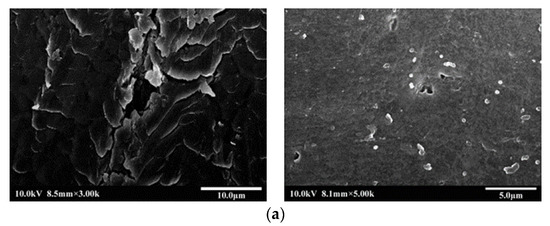
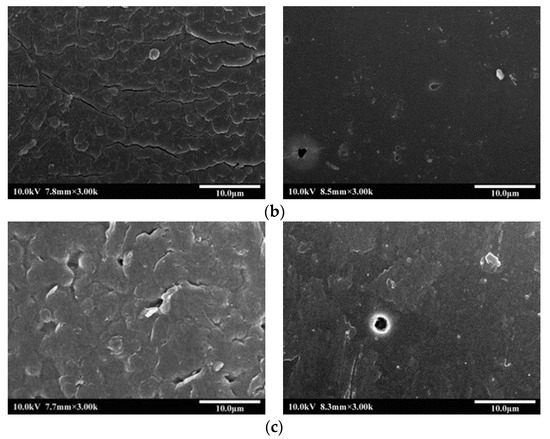
Figure 3.
The PFGPA membranes in IPA/water (left) and THF (right) with various alkali treatments. (a) 1 M NaOH, (b) 16% Na4SiO4, (c) 20% Na4SiO4.
3.2.2. IR Analysis
The IR spectrograms of the pristine, 16% Na4SiO4-treated and grafted PVDF, and the PFGPA membranes are presented in Figure 4. In the pristine PVDF membranes, absorption bands at 1400 cm−1, 1164 cm−1, and 879 cm−1 were the characteristic peaks of PVDF, representing the C–C, C–F, and –CH2 vibrations, respectively. After the treatment of 16% Na4SiO4, the absorption band of the C=C bond at 1564 cm−1 appeared, indicating the formation of the active points. The grafted PVDF membranes showed the appearance of absorption bands at 2235 cm−1, which was attributed to the C≡N bond of AN [26] and 700 cm−1 assigned to the aromatic C–H deformation of the mono-substituted benzene ring of AMS [16], whereas the absorption band of the C=C bond at 1564 cm−1 disappeared, showing that the AMS and AN had been successively grafted into the PVDF. After the grafted PVDF was sulfonated, the membranes manifested new absorption bands at 1035 cm−1 and 1006 cm−1, which were the characteristic peaks of the –SO3H group [16]. The absorption band at 700 cm−1 disappeared, confirming the sulfonation of AMS. It was also noted that in the PFGPA membranes, a lower absorption peak at 1660 cm−1 emerged, indicating a partial hydrolysis of the CN bond to the carboxyl group [32].
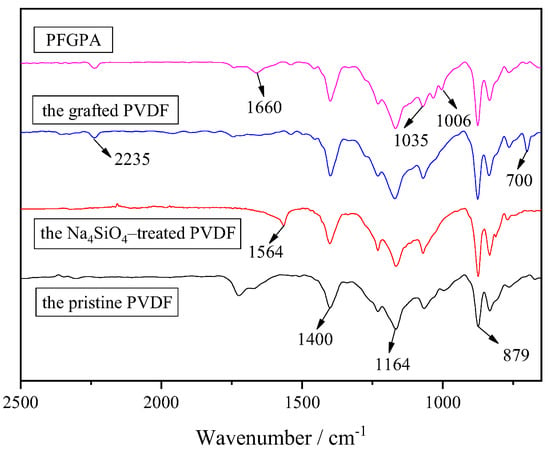
Figure 4.
The IR spectrum of the modified PVDF membranes.
3.2.3. XPS
The XPS analysis of the PFGPA membranes with the treatment of 16% Na4SiO4 is shown in Figure 5. The PFGPA membranes showed peaks of C 1s and F 1s at about 285 eV and 688 eV, attributed to the PVDF backbone [17]. The peaks of N 1s, O 1s, and S 2p at about 400 eV, 532 eV, and 168 eV, respectively, confirmed the grafting of AMS and AN into the PVDF membranes and sulfonation of the grafted PVDF membranes. Si 2p at 182 eV was also observed, indicating the residue of silicon oxide from Na4SiO4. From the N 1s core-level spectrum (Figure 5b), the N 1s spectrum of the PFGPA membrane could be curve-fitted with two peaks at the BEs of 399.89 eV and 401.55 eV due to the N≡C– and –NH–CO– groups, respectively, which demonstrated that the N≡C units had been partly protonated during the hydrolysis process to generate the amide groups [32]. The peak of O 1s at around 532 eV was curve-fitted with four peaks at the BEs of 531.65 eV, 532.10 eV, 532.90 eV, and 533.90 eV, corresponding to –SO3H, silicon oxide, –CONH2, and –COOH, respectively. This showed that a few N≡C groups in AMS were hydrolyzed into amides and carboxylic acid.
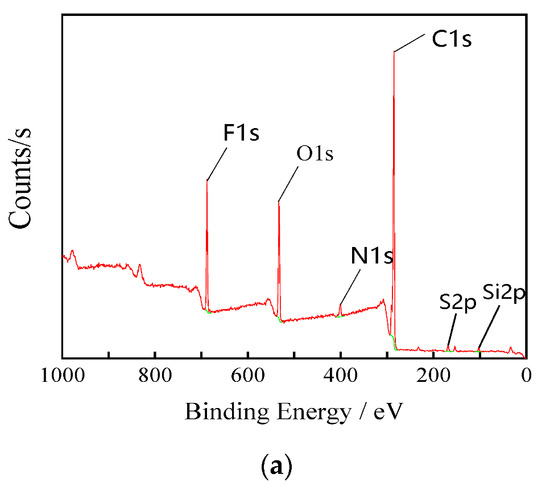
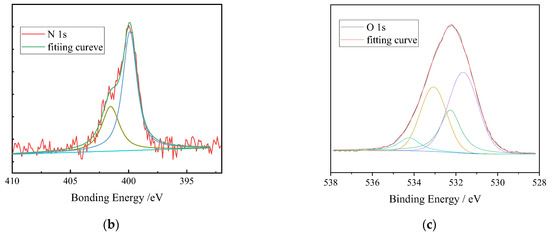
Figure 5.
The XPS (a), N1s (b), and O1s (c) fitting curves of the PFGPA membranes.
Therefore, it was concluded that PVDF-g-P(AMS-co-AN) had been successfully prepared and the sulfonic grafted PVDF membranes (PFGPA) were partly hydrolyzed. The hydrolysis of the cyano groups was due to the acid sulfonation condition, under which the N≡C groups were first hydrolyzed into the amides and then converted into the carboxylic acid [26]. The hydrolysis of the cyano groups was unexpected [26] and the sulfonation of the PFGPA membranes will be systematically investigated later.
3.3. Performances of the PFPGA Membranes
In our experiments, due to the higher grafting degree of 40–50 percent by 16% or 20% Na4SiO4 treatment, four types of the PFGPA membranes in either THF or IPA/water (I/W) were selected to measure their properties.
3.3.1. Liquid Uptake Capability and Area Swelling
In this section, three liquids, deionized water, 1 M methanol aqueous solution, and pure methanol, were used to evaluate the liquid uptake capability and area swelling.
Figure 6 shows the water uptake capabilities and area swelling of various PFGPA membranes for 192 h. For the water uptake capabilities, the four PFGPA membranes and Nafion all peaked and then decreased during the 192 h. The PFGPA membranes obtained in the grafting solvent of IPA/water showed a greater water uptake capability than those in THF. It was noticeable that PFGPA_16%_I/W demonstrated the quickest and greatest water uptake. It reached 75 percent at 24 h, peaked to 90 percent at 96 h, and finally decreased to 50 percent at 192 h. PFGPA_16%_THF, PFGPA_20%_THF, and PFGPA_20%_I/W showed the maximum water uptake of 82, 40, and 54 percent, respectively, much greater than the 17 percent of Nafion.
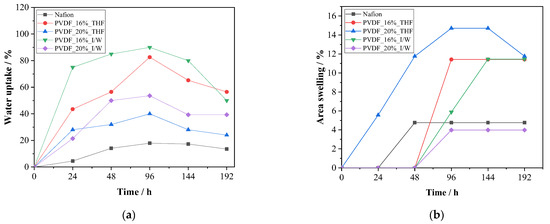
Figure 6.
The water uptake capability (a) and area swelling (b) of the PFGPA membranes during 192 h.
With respect to the area swelling in deionized water, the four PFGPA membranes peaked and then remained almost unchangeable for 192 h except that PVDF_20%_THF showed the greatest area swelling of 15 percent at 96 h and then declined. Nafion displayed a maximum area swelling of 4.76 percent at 24 h. The PFGPA membranes grafted in THF showed a greater area swelling than Nafion. The PFGPA membranes grafted in the IPA/water solvent showed a similar area swelling with Nafion at 96 h. Afterward, the PFPGA_16%_I/W manifested an increasing area, swelling to 11.5 percent. However, the PFPGA_20%_I/W maintained a lower swelling of about 4 percent. These experimental results indicated that the IPA/water solvent provided a better dimensional stability in water than THF.
Figure 7 displays the liquid uptake capabilities and area swelling of various PFGPA membranes in deionized water, 1 M methanol aqueous solution, and methanol for 48 h. Nafion showed the greatest methanol uptake capability, then the 1 M methanol aqueous solution and the water uptake was the lowest. In contrast, the four PFGPA membranes all exhibited the greatest water uptake capabilities, then the 1 M methanol aqueous solution. The methanol uptake capabilities were the lowest, no more than half that of Nafion, indicating a significant methanol resistance.

Figure 7.
The liquid uptake capabilities (a) and area swelling (b) of the PFGPA membranes for 48 h.
For the area swelling, similar to the liquid uptake capability, Nafion revealed a remarkable area swelling in methanol of about 50 percent, almost 10 times as much as that in water and 5 times in the 1 M methanol aqueous solution. However, the four PFGPA membranes exhibited an area swelling in methanol of no more than 20 percent, much lower than that of Nafion. Especially for PFGPA_16%_I/W and PFGPA_20%_I/W, the area swellings were about 5 percent, indicating a better dimensional stability and promising application in direct methanol fuel cells.
3.3.2. Chemical Stability
It is essential that the proton exchange membranes should maintain excellent chemical properties during the operation of the fuel cell. In this paper, the chemical properties of the four PFGPA membranes were evaluated by soaking in 30% H2O2 at 60 °C and the weight changes were determined. The radicals generated by H2O2 resulted in the degradation of the PVDF membranes. Figure 8 shows the weight changes of the four PFGPA membranes. In comparison, Nafion was also tested under the same experimental conditions. It was observed that Nafion showed a weight loss of less than 10 percent, indicating the best chemical stability. Except for PFGPA_16%_THF, the other three PFGPA membranes quickly descended to about 50 percent at 6 h and then leveled off. The PFGPA_16%_THF declined to about 80 percent at 18 h, then slowed down to about 75 percent, slightly lower than Nafion, but greater than 60 percent of AIEM-1 at 6% H2O2 solution by Hu [16].
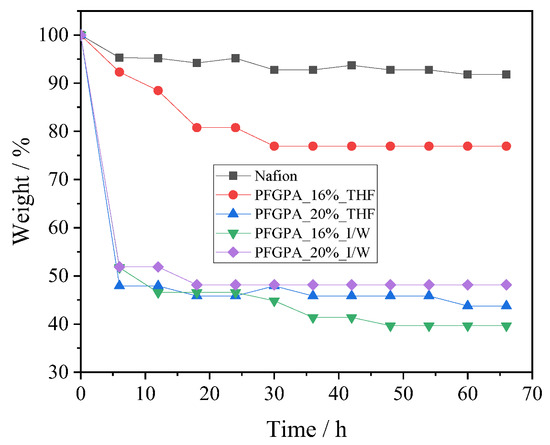
Figure 8.
The chemical stabilities of the PFGPA membranes.
On the other hand, the PFGPA_16%_THF and PFGPA_16%_I/W revealed different chemical stabilities. The grafted chains accounted for 33 percent of the weight due to their similar grafting degree of about 49 percent in Section 3.1. After degradation in H2O2, the weight of the PFGPA_16%_I/W decreased to about 40 percent, meaning that the grafted chains were almost completely degraded. However, for the PFGPA_16%_THF, the residue weight was still 75 percent. This indicated that only part of the grafted chains decomposed from the PVDF base and about 27 percent of the grafted chains were still retained, proving a better chemical stability.
3.3.3. Ion Exchange Capability and Conductivity
The PFGPA membranes have sulfonic acid groups and possess the ion exchange capacities (IEC). The measured IEC values of the four PFGPA membranes are listed in Table 1. It was noted that the IPA/water solvent in grafting polymerization displayed slightly greater IEC values of above 0.7 mmol/g than THF. In particular, PFGPA_16%_I/W displayed the greatest IEC value of 0.89 mmol/g, close to 0.91 mmol/g of Nafion measured in our experiment, exhibiting a valuable application prospect. Whenever the grafting solvent was either THF or IPA/water, the PFGPA membranes with 20% of Na4SiO4 treatment showed an IEC value of about 0.75 mmol/g. The PFGPA_16%_THF showed the lowest IEC value of 0.56 mmol/g.
Figure 9 shows the impedance plots of the PFGPA membranes and the conductivities are listed in Table 1. The impedances of Nafion and the PFGPA membranes were mainly influenced by the charge transfer process. In our experiment, Nafion showed the measured conductivity of 0.0390 S/cm with the lower solution and charge transfer impedances than the four PFGPA membranes. In comparison, the four PFGPA membranes possessed a lower conductivity of about 0.0113–0.0151 S/cm. As far as the effects of the grafting solvents were concerned, the THF resulted in a lower solution impedance than that of IPA/water. PFGPA_16%_THF and PFGPA_20%_THF possessed a similar conductivity of 0.0133 S/cm, showing that the content of Na4SiO4 never greatly influenced the proton transfer capability. For the grafting solvent of IPA/water, the conductivity of the PFGPA membranes increased with the Na4SiO4 content.
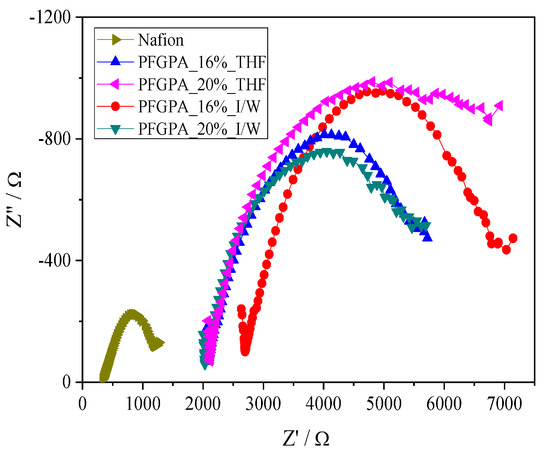
Figure 9.
The impedance plots of the PFGPA membranes.
3.3.4. Mechanical Properties
So far, many of the PVDF-based proton exchange membranes by radiation grafting have been synthesized as substituents for Nafion [15,16,17,18], but few of their mechanical properties have been reported. In general, the radiation grafting destroyed the backbones of the PVDF and thus decreased the mechanical properties. The greater the grafting degree, the greater the decrease in the mechanical property. In this paper, the mechanical properties of the obtained PFGPA membranes were measured and the data are listed in Table 2. The effects of the alkali treatments and grafting solvents are discussed below.

Table 2.
The mechanical properties of the PFGPA membranes.
The PEMs have to possess the excellent mechanical properties to withstand the tough operating conditions. To investigate the mechanical properties of the PFGPA membranes, the pristine and Na4SiO4-treated PVDF membranes and the NaOH-treated PFGPA membranes were used as a contrast. The pristine PVDF membranes showed an obvious plastic deformation with the broken stress of 34.07 MPa, a strain of 17.6%, and elastic modulus of 1771.37 MPa. After the PVDF was treated by Na4SiO4, the mechanical properties declined dramatically. Treatment by 16% Na4SiO4 showed a stress of 8.27 MPa and strain of 4.8 percent, a quarter of the pristine PVDF membranes. Treatment by 20% Na4SiO4 intensified the decrease with the stress of 4.62 MPa and the strain of 5.1 percent. After the grafting polymerization and sulfonation, compared with the PVDF_16%, the PFGPA_16%_I/W and PFGPA_16%_THF decreased in broken strain to about a half, indicating a worse mechanical property. The IPA/water brought about a lower decline in strain than the THF. For the PVDF_20%_THF and PVDF_20%_I/W, the membranes were too fragile to be measured under the experimental conditions.
Comparatively, the PFGPA_NaOH_THF and PFGPA_NaOH_I/W showed the broken stresses of 12.53 MPa and 7.14 MPa, and strains of 4.9% and 4.0%, respectively, which were close to PVDF_16% and greater than PFGPA_16%_THF and PFGPA_16%_I/W. These could be explained by the fact that PFGPA_NaOH_THF and PFGPA_NaOH_I/W possessed the grafting degree of about 35 percent, lower than 49 percent of PFGPA_16%_THF and PFGPA_16%_I/W, which resulted in a lower decrease in the mechanical property.
Our experiments demonstrated that the alkali treatment influenced the mechanical property of the PVDF membranes. The alkali treatment destroyed the PVDF backbone more than the grafting polymerization and sulfonation. The Na4SiO4 treatment led to a greater decrease in mechanical property than the NaOH treatment and the obtained PFGPA membranes became fragile [33].
4. Conclusions
The PFGPA membranes were prepared by alkali-induced grafting polymerization and subsequent sulfonation. The AMS could be grafted with AN into the PVDF base and IR and XPS analysis testified that AMS and AN were successfully grafted into the PVDF backbone and a partial hydrolysis of the CN group in AN occurred. A higher alkali content resulted in a higher grafting degree. THF as the grafting solvent could dissolve the AMS and AN, so that a smoother membrane and higher grafting degree were obtained than that in the IPA/water solvent. The PFGPA membranes exhibited a greater water uptake capability and better dimensional stability in methanol than Nafion, though they possessed lower IEC values and conductivities. The PFGPA_16%_THF membrane with a grafting degree of 49 percent manifested a slightly lower chemical stability than Nafion, indicating a promising application. It was also noted that the alkali treatment brought about a decrease in the mechanical property of the PVDF membranes and limits their practical application in fuel cells. The next research will focus on the enhancement of the conductivities of the PFGPA membranes and the improvement in the mechanical properties. The obtained experimental conclusions would be instructive to optimize the PFGPA membranes prepared by an alkali-grafted polymerization and promote their practical applications in PEMs.
Author Contributions
Conceptualization, S.L.; Data curation, formal analysis, investigation, and resources, X.L.; Software, P.F. and Y.Z.; Writing—original draft and writing—review & editing, S.L. All authors have read and agreed to the published version of the manuscript.
Funding
This research was funded by the National Natural Science Fund of China (grant number 51603144).
Acknowledgments
The authors would like to thank the Analytical & Testing Center of Tiangong University for the SEM, IR, and XPS analysis.
Conflicts of Interest
The authors declare no conflict of interest.
References
- Ke, X.; Zhang, Y.; Gohs, U.; Drache, M.; Beuermann, S. Polymer electrolyte membranes prepared by graft copolymerization of 2-acrylamido-2-methylpropane sulfonic acid and acrylic acid on PVDF and ETFE activated by electron beam treatment. Polymers 2019, 11, 1175. [Google Scholar] [CrossRef] [PubMed] [Green Version]
- Mojarrad, N.R.; Iskandarani, B.; Taşdemir, A.; Yürüm, A.; Gürsel, S.A.; Kaplan, B.Y. Nanofiber based hybrid sulfonated silica/P(VDF-TrFE) membranes for PEM fuel cells. Int. J. Hydrogen Energy 2021, 46, 13583–13593. [Google Scholar] [CrossRef]
- Vijayalekshmi, V.; Khastgir, D. Fabrication and comprehensive investigation of physicochemical and electrochemical properties of chitosan-silica supported silico tungstic acid nanocomposite membranes for fuel cell applications. Energy 2018, 142, 313–330. [Google Scholar]
- Heitner-Wirguin, C. Recent advances in perfluorinated ionomer membranes: Structure, properties and applications. J. Membr. Sci. 1996, 120, 1–33. [Google Scholar] [CrossRef]
- Ketpang, K.; Lee, K.; Shanmugam, S. Facile synthesis of porous metal oxide nanotubes and modified Nafion composite membranes for polymer electrolyte fuel cells operated under low relative humidity. ACS Appl. Mater. Interfaces 2014, 6, 16734–16744. [Google Scholar] [CrossRef]
- Nagarale, R.K.; Gohil, G.S.; Shahi, V.K.; Rangarajan, R. Organic/inorganic hybrid membrane: Thermally stable cation-exchange membrane prepared by the sol–gel method. Macromolecules 2003, 37, 10023–10030. [Google Scholar] [CrossRef]
- Rikukawa, M.; Sanui, K. Proton-conducting polymer electrolyte membranes based on hydrocarbon polymers. Prog. Polym. Sci. 2000, 25, 1463–1502. [Google Scholar] [CrossRef]
- Hickner, M.A.; Ghassemi, H.; Kim, Y.S.; Einsla, B.R.; McGrath, J.E. Alternative polymer systems for proton exchange membranes (PEMs). Chem. Rev. 2004, 104, 4587–4612. [Google Scholar] [CrossRef]
- Oh, K.; Kwon, O.; Son, B.; Lee, D.H.; Shanmugam, S. Nafion-sulfonated silica composite membrane for proton exchange membrane fuel cells under operating low humidity condition. J. Membr. Sci. 2019, 583, 103–109. [Google Scholar] [CrossRef]
- Gubler, L.; Gürsel, S.A.; Scherer, G.G. Radiation grafted membranes for polymer electrolyte fuel cells. Fuel Cells 2005, 5, 317–335. [Google Scholar] [CrossRef]
- Chen, J.; Asano, M.; Maekawa, Y.; Sakamura, T.; Kubota, H.; Yoshida, M. Preparation of ETFE-based fuel cell membranes using UV-induced photografting and electron beam-induced crosslinking techniques. J. Membr. Sci. 2006, 283, 373–379. [Google Scholar] [CrossRef]
- Hasegawa, S.; Suzuki, Y.; Maekawa, Y. Preparation of poly(ether ether ketone)-based polymer electrolytes for fuel cell membranes using grafting technique. Radiat. Phys. Chem. 2008, 77, 617–621. [Google Scholar] [CrossRef]
- Chen, J.; Asano, M.; Yamaki, T.; Yoshida, M. Preparation and characterization of chemically stable polymer electrolyte membranes by radiation-induced graft copolymerization of four monomers into ETFE films. J. Membr. Sci. 2006, 269, 194–204. [Google Scholar] [CrossRef]
- Fu, R.Q.; Woo, J.J.; Seo, S.J.; Lee, J.S.; Moon, S.H. Sulfonated polystyrene/polyvinyl chloride composite membranes for PEMFC applications. J. Membr. Sci. 2008, 309, 156–164. [Google Scholar] [CrossRef]
- Zhang, Z.; Jetsrisuparb, K.; Wokaun, A.; Gubler, L. Study of nitrile-containing proton exchange membranes prepared by radiation grafting: Performance and degradation in the polymer electrolyte fuel cell. J. Power Sources 2013, 243, 306–316. [Google Scholar] [CrossRef]
- Hu, G.; Wang, Y.; Ma, J.; Qiu, J.; Peng, J.; Li, J.; Zhai, M. A novel amphoteric ion exchange membrane synthesized by radiation-induced grafting α-methylstyrene and N, N-dimethylaminoethyl methacrylate for vanadium redox flow battery application. J. Membr. Sci. 2012, 407–408, 184–192. [Google Scholar] [CrossRef]
- Qiu, X.; Li, W.; Zhang, S.; Liang, H.; Zhu, W. The Microstructure and character of the PVDF-g-PSSA membrane prepared by solution grafting. J. Electrochem. Soc. 2003, 150, 917–921. [Google Scholar] [CrossRef]
- Guo, G.B.; An, S.L.; Kou, S.S. Preparation and properties of modified poly(vinylidene fluoride) grafted with polystyrene sulfonated acid membrane. Polym. Mater. Sci. Eng. 2010, 26, 112–115. [Google Scholar]
- Hübner, G.; Roduner, E. EPR investigation of HO/radical initiated degradation reactions of sulfonated aromatics as model compounds for fuel cell proton conducting membranes. J. Mater. Chem. 1999, 9, 409–418. [Google Scholar] [CrossRef]
- Dockheer, S.M.; Gubler, L.; Bounds, P.L.; Domazou, A.S.; Scherer, G.G.; Wokaun, A.; Koppenol, W.H. Damage to fuel cell membranes. Reaction of HO with an oligomer of poly(sodium styrene sulfonate) and subsequent reaction with O2. Phys. Chem. Chem. Phys. 2010, 12, 11609–11616. [Google Scholar] [CrossRef]
- Gursel, S.A.; Yang, Z.; Choudhury, B.; Roelofs, M.G.; Scherer, G.G. Radiation grafted membranes using a trifluorostyrene derivative. J. Electrochem. Soc. 2006, 10, A1964–A1970. [Google Scholar] [CrossRef]
- Hodgdon, R.B. Sulfonated Polymers of α, α, β-Trifluorostyrene, with Applications to Structures and Cells. U.S. Patent 3341366, 12 September 1967. [Google Scholar]
- Chen, J.; Asano, M.; Yamaki, T.; Yoshida, M. Improvement of chemical stability of polymer electrolyte fuel cell membranes by grafting of new substituted styrene monomers into ETFE films. J. Mater. Sci. 2006, 41, 1289–1292. [Google Scholar] [CrossRef]
- Assink, R.A.; Arnold, C.; Hollandsworth, R.P. Preparation of oxidatively stable cation-exchange membranes by the elimination of tertiary hydrogens. J. Membr. Sci. 1991, 56, 143–151. [Google Scholar] [CrossRef]
- Sharma, K.R. Thermal terpolymerization of alpha-methylstyrene, acrylonitrile and styrene. Polymer 2000, 41, 1305–1308. [Google Scholar] [CrossRef]
- Woo, J.J.; Seo, S.J.; Yun, S.H.; Fu, R.Q.; Yang, T.H.; Moon, S.H. Enhanced stability and proton conductivity of sulfonated polystyrene/PVC composite membranes through proper copolymerization of styrene with alpha-methylstyrene and acrylonitrile. J. Membr. Sci. 2010, 363, 80–86. [Google Scholar] [CrossRef]
- Li, J.; Muto, F.; Miura, T.; Oshima, A.; Washio, M.; Ikeda, S.; Katsumura, Y. Improving the properties of the proton exchange membranes by introducing alpha-methylstyrene in the pre-irradiation induced graft polymerization. Eur. Polym. J. 2006, 42, 1222–1228. [Google Scholar] [CrossRef]
- Gubler, L.; Slaski, M.; Wallasch, F.; Wokaun, A.; Scherer, G.G. Radiation grafted fuel cell membranes based on co-grafting of alpha-methylstyrene and methacrylonitrile into a fluoropolymer base film. J. Membr. Sci. 2009, 339, 68–77. [Google Scholar] [CrossRef]
- Guo, G.B.; An, S.L.; Kou, S.S. Preparation and performance of modified poly(vinylidene fluoride) grafted onto a blended polystyrene sulfonated acid membrane. Acta Phys.-Chim. Sin. 2009, 25, 2161–2166. [Google Scholar]
- Riberio, M.R.; Portela, M.F.; Deffieux, A.; Cramail, H.; Rocha, M.F. Isospecific homo and copolymerization of styrene with ethylene in the presence of VCl3, AlCl3 as catalyst. Macromol. Rapid Commun. 1996, 17, 461–469. [Google Scholar] [CrossRef]
- Deng, Y.; Peng, C.; Liu, P.; Lu, J.; Zeng, L. Studies on the cationic copolymerization of alpha-pinene and styrene with complex SbCl3/AlCl3 catalyst systems. 1. Effects of the polymerization conditions on the copolymerization products. J.M.S. Pure Appl. Chem. 1996, A33, 995–1004. [Google Scholar]
- Henkensmeier, D.; Wallasch, F.; Gubler, L. Radiation grafted ETFE-graft-poly(α-methyl styrenesulfonic acid-co-methacrylonitrile) membranes for fuel cell applications. J. Membr. Sci. 2013, 447, 228–235. [Google Scholar] [CrossRef]
- Dias, A.J.; McCarthy, T.J. Dehydrofluorination of poly(vinylidene Fluoride) in dimethylformamide solution: Synthesis of an operationally soluble semiconducting polymer. J. Polym. Sci. Polym. Chem. E 1985, 23, 1057–1061. [Google Scholar] [CrossRef]
Publisher’s Note: MDPI stays neutral with regard to jurisdictional claims in published maps and institutional affiliations. |
© 2022 by the authors. Licensee MDPI, Basel, Switzerland. This article is an open access article distributed under the terms and conditions of the Creative Commons Attribution (CC BY) license (https://creativecommons.org/licenses/by/4.0/).